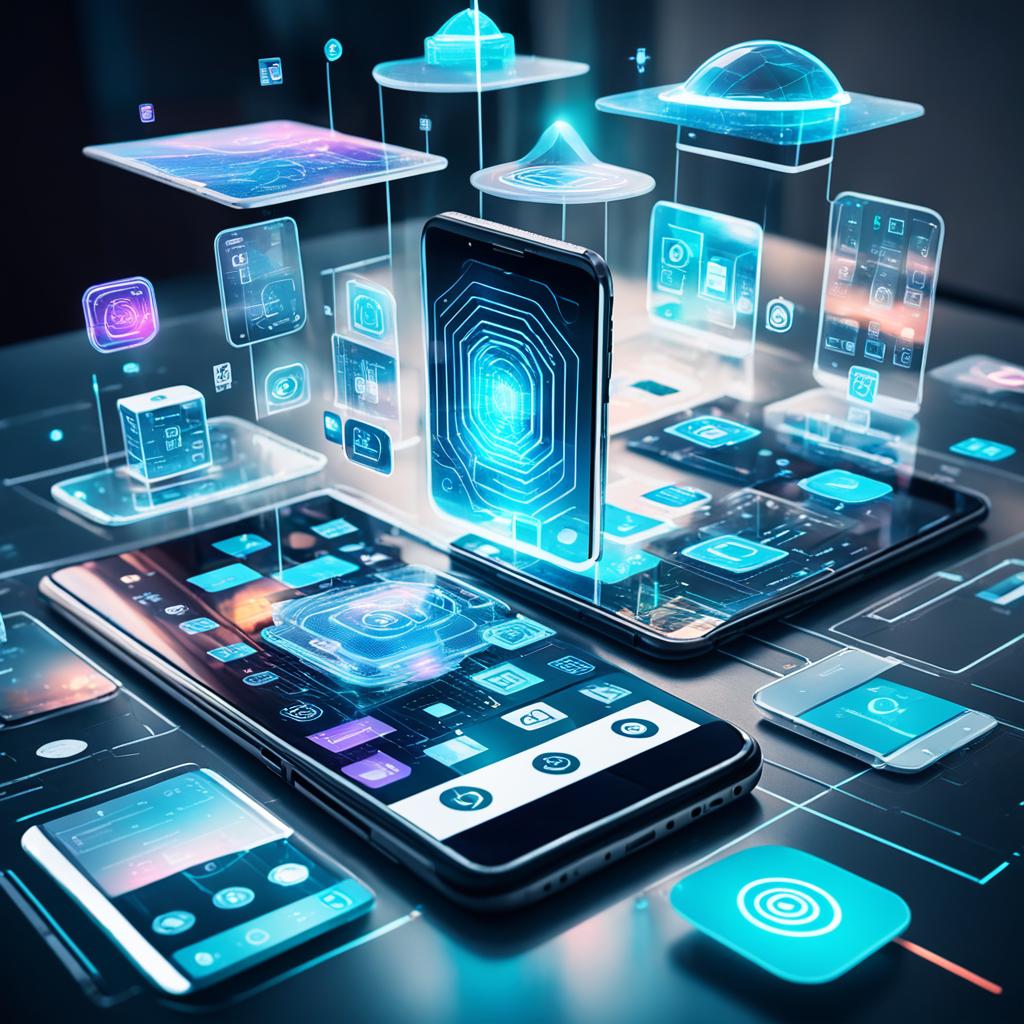Advertisements
Have you ever imagined watching a movie at home, with a simple smartphone, and seeing virtual characters interacting with their real environment? Or virtually try on an outfit before buying it, without leaving home? These are just some of the possibilities that augmented reality on mobile devices offers.
Augmented reality (AR) is a technology that is revolutionizing the way we interact with the world around us. By integrating virtual elements into the real environment, it provides more immersive and interactive experiences. In recent years, the augmented reality on mobile devices has gained prominence, driven by the growth of e-commerce and the accessibility of smartphones.
Advertisements
In this article, we will explore the augmented reality industry trends on mobile devices and how this technology is transforming our daily lives. Let's find out how to use augmented reality user manual can make instructions more effective, such as virtual fitting room is revolutionizing the online shopping experience and how the combination of augmented reality and artificial intelligence is driving new possibilities.
Main points of the article:
- What is augmented reality and how it works
- To the augmented reality industry trends on mobile devices
- The use of augmented reality user manual
- The transformation of online shopping experience as virtual fitting room
- The combination of augmented reality with artificial intelligence
- Accessibility and augmented reality cost reduction
What is augmented reality?
Augmented reality is a technology that superimposes virtual images onto the user's perspective in the real world. It allows for an interactive experience, enriching the real world with virtual elements.
Advertisements
Currently, users can interact with augmented reality through smartphones and other devices. This technology is different from virtual reality, which provides a complete experience in the virtual world, without visual interaction with the real world.
Augmented reality is more accessible and widely applicable in various sectors, such as medicine, construction and e-commerce.
Augmented reality is an innovative technology that is positively impacting the way we interact with the world around us. Its ability to superimpose virtual elements onto the real world offers infinite possibilities for immersive and interactive experiences.
See too:
For example, in medicine, augmented reality is being used to assist in surgeries, allowing doctors to view important information about the patient in real time during the procedure. In civil construction, technology is applied to help architects and engineers visualize projects on a full scale, enabling a better understanding of the final result even before construction begins.
Applications of augmented reality in different sectors:
| Sector | Augmented Reality Applications |
|---|---|
| Medicine | Surgery support, virtual medical training, viewing medical exams |
| Construction | Visualization of projects, simulation of structures, assistance with inspections and maintenance |
| E-commerce | Virtual fitting room, product demonstration, mapping of advertising spaces |
Augmented reality is also present in entertainment applications, allowing users to interact with virtual characters in their physical environment. Furthermore, it can be used to improve the customer experience in physical stores, providing additional information about a specific product when pointing the smartphone at it.
Augmented reality is a revolutionary technology that is transforming the way we interact with the world around us. Its ability to integrate virtual elements into the real world offers incredible potential across industries, from medicine to e-commerce.
With the continuous advancement of technology, augmented reality is expected to become even more present in our daily lives, providing increasingly immersive and impactful experiences. It is a trend that is here to stay and revolutionize the way we interact with the digital and physical world.
Augmented reality industry trends
The augmented reality industry is undergoing several transformations and boosting the use of this technology in different business areas. Some of the key trends include:
- Integration of augmented reality on mobile devices
- Applications of augmented reality in education
- Growth in the use of augmented reality in e-commerce
- Advances in augmented reality for healthcare and medicine
- Expanding Augmented Reality for Entertainment and Gaming
The integration of augmented reality on mobile devices is one of the main trends in the industry. With the popularity of smartphones, more and more apps and features are being developed to offer immersive experiences to users on their mobile devices.
Augmented reality is providing new ways of learning and interacting in education. In addition to making classes more dynamic and engaging, it allows students to visualize and manipulate virtual objects, making it easier to understand complex concepts.
In e-commerce, augmented reality has played a fundamental role in improving the consumer experience. The ability to view products in 3D and virtually try them on before purchasing has helped reduce return rates and increase customer satisfaction.
The healthcare sector has also benefited from the applications of augmented reality. It is being used in computer-assisted surgery, medical training and patient rehabilitation, allowing for more accurate diagnoses and more effective treatments.
The entertainment and gaming industry is exploring various possibilities with augmented reality. Augmented reality games offer immersive experiences by combining the real world with virtual elements, providing a new form of interaction and entertainment for players.
These trends demonstrate the potential of augmented reality to transform various areas of business and provide richer and more interactive experiences for users.

Implications of augmented reality on mobile devices
The increasing integration of augmented reality on mobile devices brings with it several implications for society and the way we interact with the world around us. In addition to the advantages mentioned above, augmented reality on mobile devices can also:
- Facilitate real-time information detection
- Promote gamification in different contexts
- Stimulate the development of innovative applications
- Increase demand for professionals specializing in augmented reality
These implications indicate that augmented reality on mobile devices is consolidating itself as a revolutionary technology with the potential to transform several sectors and aspects of our lives.
Augmented Reality User Manual
Using the user manual in augmented reality is becoming a growing trend across many industry sectors. This technology allows instructions to be presented in a more effective and immersive way, replacing traditional paper manuals. When you point your smartphone camera at a product, the manual content is overlaid on the product in real time, offering clear and specific instructions. This increases the chances of repair, reduces engagement time, improves productivity and provides a better post-purchase experience.

Advantages of Augmented Reality User Manual:
- Greater effectiveness of instructions;
- Immersive and interactive experience;
- Reduction of errors and involvement time;
- Improvement in productivity;
- Better post-purchase experience.
By utilizing augmented reality to provide a user manual more dynamic and visual, consumers benefit from a more efficient and effective way of learning. Users can visualize the assembly, repair or use steps of a specific product more clearly and intuitively thanks to real-time information overlay.
Augmented reality is transforming the way we learn and engage with the technology around us. O augmented reality user manual is a clear example of how this technology can enhance the user experience and provide more efficient instructions for consumers.
Additionally, this approach also provides a better post-purchase experience, as users can resolve issues or queries quickly and easily without the need to consult bulky manuals or contact customer support. This convenience results in greater customer satisfaction and, consequently, greater chances of loyalty and repurchase.
Example of augmented reality user manual:
| Product | Description | Instructions in Augmented Reality |
|---|---|---|
| XYZ Smartphone | Latest smartphone model with many features. | By pointing your smartphone's camera at the device, you can see detailed instructions for setting up, using features and troubleshooting superimposed on the screen. |
| ABC DSLR Camera | Professional camera for high quality photography. | Using augmented reality, you can see camera settings overlaid on the camera, allowing for precise adjustments and making it easier to explore all available features. |
Virtual fitting room
The virtual fitting room is an augmented reality trend that is transforming online shopping experience. With the growth of e-commerce sales, consumers are often unable to physically try products before purchasing. The virtual fitting room uses augmented reality to allow consumers to virtually “try on” clothes, accessories and makeup, for example. This provides a more complete and realistic shopping experience, increasing customer satisfaction and reducing return rates.
With the help of the virtual fitting room, consumers can visualize how clothes look on their bodies, test accessory combinations and even try different shades and textures of makeup before making a purchase. This technology brings the feeling of being in a physical store, without leaving home.
The online shopping experience becomes more personalized and interactive with the use of the virtual fitting room. Consumers can explore different product options, try different sizes and styles, without worrying about returns and exchanges. This results in increased customer satisfaction as they have a more accurate idea of how the product will actually fit into their lives.
The virtual fitting room is an innovative solution that allows consumers to have an online shopping experience closer to reality. With the ability to virtually try on products, consumers feel more confident about making a purchase, which reduces return rates and increases the efficiency of customer service processes.
Furthermore, the virtual fitting room also brings benefits to companies. By reducing return rates, companies save on product shipping, processing and refund costs. At the same time, they increase your sales conversions and customer loyalty.
In short, the virtual fitting room is a powerful tool that is revolutionizing the online shopping experience. With augmented reality, consumers can virtually try on products before purchasing, which increases customer satisfaction, reduces return rates, and boosts e-commerce sales.
Augmented reality and Artificial Intelligence
The combination of augmented reality with the artificial intelligence is driving new possibilities in the use of this technology. Artificial intelligence allows the creation of more advanced and efficient immersive experiences, expanding the potential of augmented reality.
An example of application of this combination is Google Translate. Using the smartphone's camera, the application uses augmented reality to translate text in real time, facilitating communication in different languages. This integration between augmented reality and artificial intelligence provides a more practical and effective experience for users, expanding the functionalities of this technology.
With the continuous advancement of technology augmented reality and artificial intelligence, these combinations are expected to be increasingly recurrent. This will open doors for the development of more sophisticated and innovative applications in areas such as entertainment, education, healthcare, architecture and much more. The union of these two complementary technologies is bringing new perspectives and transforming the way we interact with the world around us.
Benefits of combining Augmented Reality and Artificial Intelligence
The combination of augmented reality with artificial intelligence offers a series of benefits, both for users and for companies that explore these technologies. Some of the key benefits include:
- Immersive experiences: The combination of these technologies provides more immersive and interactive experiences, creating a virtual world integrated with the real world.
- Improved efficiency: Artificial intelligence enables rapid processing and recognition of objects and information in augmented reality, speeding up tasks and activities.
- Advanced personalization: Artificial intelligence can be used to analyze data and deliver personalized, relevant content to each user, enhancing the individual experience.
- Applications in various sectors: The combination of augmented reality with artificial intelligence has potential for application in areas such as e-commerce, tourism, education, medicine, among others.
Example of Application of the Combination of Augmented Reality and Artificial Intelligence
A practical example of this combination is the use of augmented reality and artificial intelligence in the field of medicine. Through devices such as augmented reality glasses, doctors can access real-time information during complex surgeries. Artificial intelligence works to identify organs, blood vessels and other relevant elements, providing visual guides superimposed on the doctor's vision.
Furthermore, the combination of augmented reality and artificial intelligence It can assist doctors in diagnosing, analyzing medical images and monitoring patients, improving the accuracy of procedures and reducing risks.
| Benefits | Example of Application in Medicine |
|---|---|
| Detailed view of internal organs and structures | Doctors can use augmented reality to visualize and interact with internal organs during surgery, providing greater precision and safety |
| Real-time assistance during procedures | Artificial intelligence-powered augmented reality glasses can provide real-time information and visual guides during complex surgeries, helping doctors make more accurate decisions |
| Advanced diagnosis and analysis of medical images | Artificial intelligence can be used to analyze imaging exams, identifying patterns and anomalies that may go unnoticed, helping doctors diagnose and treat diseases |
Accessibility and cost reduction
Augmented reality is becoming increasingly accessible to users, thanks to technological advances and the popularization of smartphones. With falling costs and increasing quality of technology, the application of augmented reality becomes more accessible and beneficial for both companies and consumers.
In addition to providing an immersive and interactive experience, augmented reality also contributes to increased sales in e-commerce, conveying greater relevance, trust and authority to companies.
| Advantages of Augmented Reality Accessibility | Cost Reduction Benefits of Augmented Reality |
|---|---|
|
|
These advantages and benefits make augmented reality a viable and valued solution for companies in different segments, such as retail, education, healthcare and industry.
See below an example of how augmented reality can be used in healthcare:
A augmented reality accessibility allows people with visual impairments to access important information about their health. Through applications compatible with screen readers, patients can receive instructions, guidance and even view virtual models of their own body, facilitating the understanding of medical procedures and contributing to more complete and effective treatment.
Conclusion
Augmented reality on mobile devices is revolutionizing the way people interact with the world around them. With resources such as the augmented reality user manual, the virtual fitting room and the combination of augmented reality with artificial intelligence, companies can provide more immersive, personalized and interactive experiences to consumers.
Furthermore, accessibility and cost reduction make the application of augmented reality increasingly advantageous. To the augmented reality industry trends are transforming several sectors, such as commerce, industry and services. Applying this technology can boost sales, improve the customer experience and stand out in the market.
Taking advantage of trends and the use of augmented reality on mobile devices is essential for companies that want to stand out and offer a unique experience to consumers. With benefits such as greater engagement, interactivity and efficiency, augmented reality presents itself as a powerful tool to create a competitive advantage and achieve success in the digital world.
FAQ
What is augmented reality?
Augmented reality is a technology that superimposes virtual images on the user's perspective in the real world, providing an interactive experience and enriching the real environment with virtual elements.
What are the trends in the augmented reality industry?
Some of the key trends in the augmented reality industry include the use of the augmented reality user manual, the virtual fitting room, and the combination of augmented reality and artificial intelligence.
How does the augmented reality user manual work?
The augmented reality user manual uses the overlay of virtual information on the product in real time, providing clear and specific instructions through the smartphone camera, replacing traditional paper manuals.
What is the virtual fitting room?
The virtual fitting room is an augmented reality trend that allows consumers to virtually “try on” clothes, accessories and makeup before purchasing them, providing a more complete and realistic shopping experience.
How can the combination of augmented reality and artificial intelligence be applied?
The combination of augmented reality with artificial intelligence allows the creation of more advanced and efficient immersive experiences, such as the Google Translate application, which uses the smartphone's camera to translate text in real time.
Is augmented reality accessible to users?
Yes, augmented reality has become increasingly accessible to users due to technological advances and the popularization of smartphones, which results in a drop in costs and an increase in the quality of the technology.
What are the benefits of applying augmented reality?
In addition to providing an immersive and interactive experience, augmented reality contributes to increased sales in e-commerce, conveys greater relevance, trust and authority to companies and improves the customer experience.
